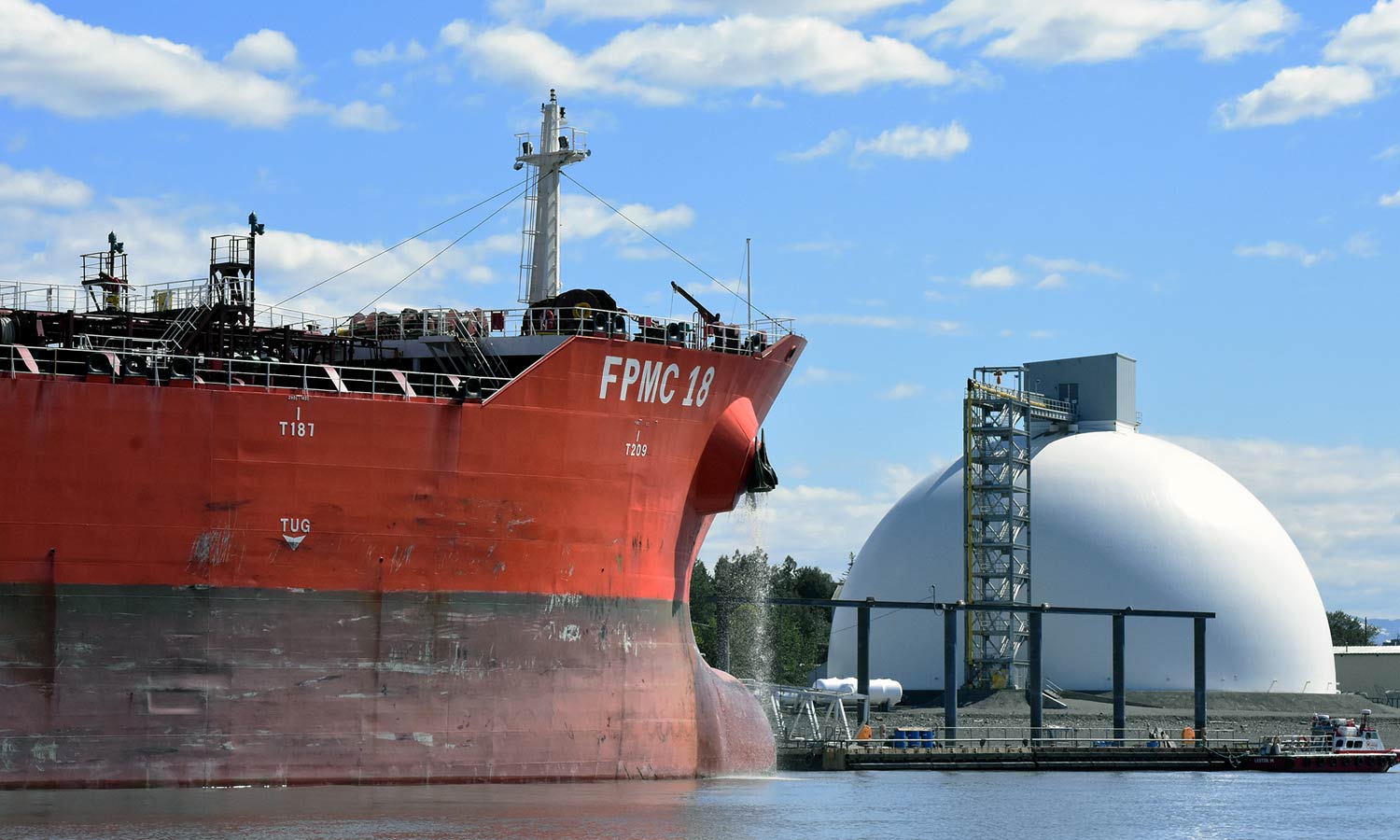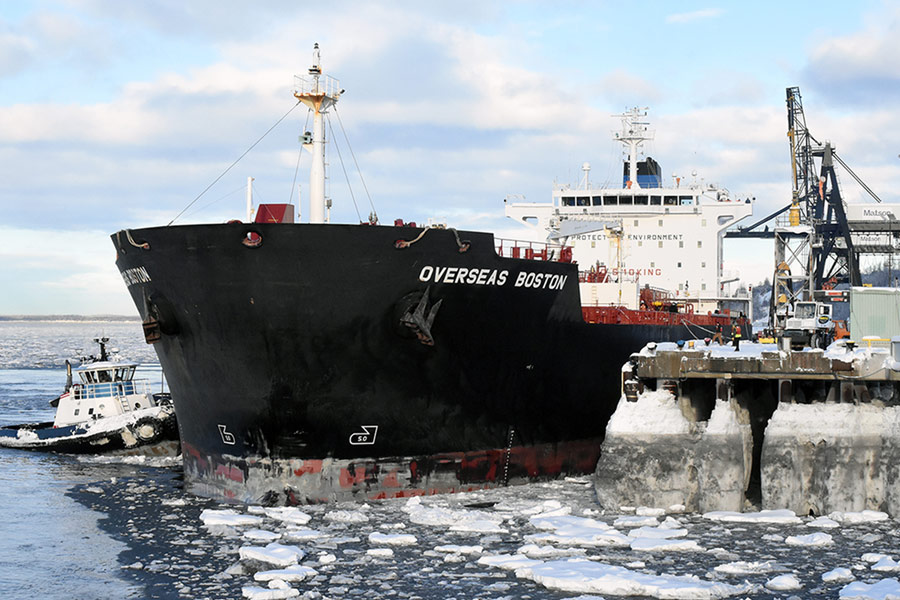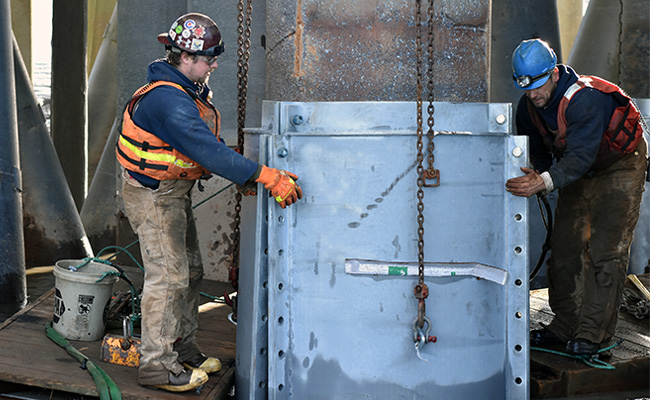
An Infrastructure Crossroads
Aging port has big challenge
By Steve Ribuffo
According to the American Society of Civil Engineers (ASCE), the United States is facing a critical juncture. Infrastructure throughout our country is in a sad state of disrepair, deteriorating rapidly in 16 major categories. The situation is impeding our nation’s ability to compete in a thriving global economy, and dramatic improvements are necessary to ensure the country is built for the future.
I, and others charged with the safekeeping of crucial infrastructure facilities, feel the U.S. can no longer afford to defer infrastructure investment. Reversing a trajectory fueled by decades of underinvestment in the nation’s infrastructure will require transformative action from government entities, states, and infrastructure owners.
In a recent ASCE study, which graded the American infrastructure system at a D+, to close the 10-year, $2 trillion investment gap, address future need, and restore a global competitive advantage, the nation must increase investment from all levels of government and the private sector from 2.5% to 3.5% of U.S. Gross Domestic Product (GDP) by 2025.
While many people automatically think of bridges and roads when it comes to infrastructure, ports are also a major infrastructure thoroughfare. Specifically, the U.S.’ 926 ports are essential to the nation’s competitiveness, serving as the gateway for 99% of overseas trade. In 2014, ports were responsible for $4.6 trillion in economic activity – roughly 26% of the U.S. economy. Nearly $1.75 trillion worth of cargo moved through seaports in 2013, and the top 10 U.S. ports accounted for 78% of U.S. foreign water trade in 2015. The movement of goods through ports supports 23.1 million jobs and provides $321.1 billion in tax revenue to federal, state, and local governments.
Why does a collapsing U.S. infrastructure matter to Alaska? Infrastructure in Alaska, like so many things, is different when compared to other areas of the U.S. Covering a vast area of more than 663,000 square miles and supporting a population of just over 730,000, there is no one mode of transport, and weather at different times of the year may alter routes. Alaska’s commercial waterway, specifically the main port facility located in Anchorage, is a critical statewide artery that needs to be maintained and operated in a safe, efficient, and sustainable manner, with not only an eye on the now but a view of the future.
Despite the state’s relatively young age, Alaska is not being spared the reality of failing infrastructure, but among us are visionaries who understand the unique aspects of Alaska’s transportation network. October 17, 2017, marked a watershed moment: The Anchorage Assembly officially changed the name of the Port of Anchorage to the Port of Alaska to signify its overall importance to state commerce, which extends past the borders of the Municipality. While hurricanes and tsunamis may not bring this port – critical to not only the Alaska military mission, but to the livelihood of 85 percent of the population – to its knees, what is causing wide concern is time and a local phenomenon called Accelerated Low Water Corrosion. So, with our 56-year history, how did we get here, and what are we doing about it?
Once upon a time in 1961, the Port of Anchorage opened for business. It was an optimistic time: Seward was the gateway to a new state, and the Cook Inlet oil boom was taking off. In July of that year, two months before the ribbon was cut, the Port welcomed its first foreign-flagged vessel when the Japanese freighter Kazukawa Maru delivered 600 tons of pipe and construction materials for Cook Inlet oil fields. It was a small load by modern standards, but the Port of Anchorage was off and running, with its volume steadily increasing until 5:36 p.m. AST on Good Friday, March 27, 1964.

That was when a magnitude 9.2 earthquake – the second most powerful earthquake ever recorded – struck Alaska beneath Prince William Sound and caused mass destruction, with shaking and tsunamis that killed 139 people as far away as Oregon and California. Fortunately, Upper Cook Inlet geography virtually eliminates tsunami danger, and the 26-foot-wave that inundated the Homer Spit was reduced to a ripple by the time it reached Anchorage.
The Port of Anchorage was the only deep-water port in Southcentral Alaska to survive that natural disaster, so it instantly turned into the state’s principal inbound cargo hub as it expanded to support earthquake reconstruction and then Alaska’s North Slope oil boom and population surge. Today the Port handles almost four million tons of fuel and freight annually – half of all marine cargo delivered into Alaska. About half of the fuel and goods crossing Anchorage docks move on to final destinations outside of the Municipality and into every region of the state.
For more than half a century, the Port of Anchorage demonstrated its economic viability and played key roles in supporting statewide growth and U.S. military missions in Alaska, the Pacific Rim, and the Arctic, while also generating jobs and revenue for the Municipality of Anchorage. The present-day Port, with its three general cargo terminals and two fuel terminals, is Alaska’s most versatile, routinely and efficiently handling flats, containers, break bulk, petroleum, dry bulk, and even cruise ships.
As Anchorage evolved into Alaska’s population center, our Port became the state’s main cargo transportation hub, supporting hundreds of millions of dollars of public and private cargo-related infrastructure, including 3.4 million barrels of liquid fuel storage, 60,000 tons of cement storage, adjacent Ship Creek area barge and rail terminals, and intermodal connections to the state’s principal marine, road, rail, air, and pipeline transport systems.
What I’d like folks to take away from this little history lesson is that the geography (remember, no tsunamis in Upper Cook Inlet), location (remember, Anchorage is the population center), and private sector infrastructure investment (remember, everything landside was constructed by the Port’s users with no public money) made here over the last 56 years, when stacked against a state population of less than 1 million people – 85 percent of which benefit directly from this Port – makes it fiscally irresponsible to think about having more than one port as robust as this one. The smarter – and, I’d argue, less expensive – business investment is in assuring resiliency in the one proven profitable enterprise already in place.
Here’s our challenge: The Port of Anchorage docks were initially constructed to last 35 years. The half-century-old facility has long exceeded its structural design and economic life, and today the facility is suffering from a slow-motion disaster of corrosion and obsolescence. Barring a major earthquake or other unexpected event, the Port is unlikely to suffer catastrophic failure that causes large numbers of casualties or disastrous property loss. Instead, it will endure a slow-motion failure from corrosion and age that will suck value out of business and infrastructure investments, while making life in Alaska more expensive and less convenient.
The Municipality of Anchorage recognized the Port’s structural and economic issues decades ago and started pursuing solutions. The initial attempt to replace the docks, called the Port Intermodal Expansion Project, did not succeed, and the Municipality is now struggling to replace the docks before they fail and cause statewide disruption. The challenge is that the Port is owned and operated by the Municipality of Anchorage, but it directly serves some 85 percent of all state residents, supports the statewide economy, and is critical to national economic and security interests.
Officials are settling on a plan to replace the Port’s aging docks while maintaining ongoing operations and minimizing costs. Once started, construction is expected to last at least seven years and cost at least $700 million. The harsh reality is that state legislators and administration officials have largely overlooked the Port’s failing dock, focusing instead on Alaska’s fiscal gap and other issues, so where the financing will be coming from is the big question going forward.
Clearly, time is running out. To prove that point, a 57,000-pound fender-pile structure broke off of the Port’s Terminal 2 last June while a ship was docking. Nobody was injured, there was no vessel damage, and surface workers and divers managed to remove the structure from the berth without delaying any ship visits. But it was a close call, and a similar incident in winter, when ice would prevent divers from entering the water, would likely close a berth for months.

Consequently, officials are now moving forward to replace docks and intend to start shore-side work and dredging in 2018 that will enable construction of a new fuel and cement terminal in 2019 just south of the existing docks. The new berth will be 45 feet deep at low tide to serve larger, modern vessels that current facilities cannot handle. And when that dock is complete, workers will move north, demolishing and replacing fuel and cargo terminals until the failing docks are replaced.
Initial work will be funded with money that remains from earlier dock-replacement efforts, but new funds will have to be raised from a combination of private and public sources. Some of the funding is expected to come from damages collected through litigation on the failed Port Intermodal Expansion Project. The federal government is expected to pay for a portion of the work to support national defense, homeland security, and commerce needs. The State may fund a portion of the project, and remaining costs will most likely be covered by Port revenue bonds that will be repaid with cargo-related fees and tariffs, which will be passed on to statewide consumers of fuel and goods transported across Anchorage’s docks.
There is no doubt as to the statewide commercial and economic impact of the Port of Alaska, but the facility holds an even more important distinction. In 2006, the Port of Anchorage was designated as a Department of Defense National Strategic Seaport. Only 19 commercial seaports in the U.S. have this designation. The designation was bestowed upon the Port in recognition of its vital role in supporting overseas military deployments and day-to-day operations.
The Port of Alaska is an investment in our future. Smart investment will only be possible with people who have the will to lead and the vision to plan. The long-term viability of the Port of Alaska is what those of us challenged with the running of this facility think about every day when we get out of bed and come to work. To steal a phrase, “failure is not an option.”

Steve Ribuffo is the Director of the Port of Alaska. In this capacity, he is responsible for overseeing the day-to-day business operations of the Port and interacting with tenants, the U.S. Coast Guard, the military, and new business prospects.
Ribuffo retired from the United States Air Force as a Colonel, having served 30 years on active duty. He is an Accredited Marine Port Executive, and a member of the Advisory Board of the International Association of Maritime Port Executives. Ribuffo also serves on the University of Alaska Anchorage’s Global Supply Chain Management curriculum advisory committee, and is Chairman of the Cook Inlet Harbor Safety Committee.
Steve Ribuffo
Director
Port of Alaska